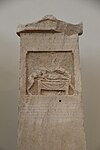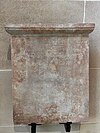

The Athenian Greek-Phoenician inscriptions are 18 ancient Phoenician inscriptions found in the region of Athens, Greece (also known as Attica). They represent the second largest group of foreign inscriptions in the region after the Thracians (25 inscriptions). 9 of the inscriptions are bilingual Phoenician-Greek and written on steles. Almost all of them bear the indication of the deceased's city of origin, not just the more general designation of their ethnicity, like most other non-Greek inscriptions in the region.[1]
| Dedicated to | Image | Type | Discovered | Date | Current Location | Concordance | ||||||
|---|---|---|---|---|---|---|---|---|---|---|---|---|
| KAI | CIS / RÉS | NE | KI | NSI | TSSI | IG II2 | ||||||
| Artemidoros son of Heliodoros of Sidon = Abdtanit, son of Abdshamash, of Sidon | 
|
Funerary | 1795 | ca. 340 BC[2] | British Museum (BM 1861,0726.1 and 1937,1211.1)[3] | 53 | I 116 | 424,2 | 45 | III 40 | 10270 | |
| Antipatros son of Aphrodisias of Askalon = Shem son of Abdashtart of Askalon | 
|
Funerary | 1861 | 300s BC | National Archaeological Museum, Athens (NM 1488) | 54 | I 115 | 424,1 | 46 | 32 | 8388 | |
| Benḥudeš, son of 'Abdmilqart, son of 'Abdšamaš, son of TGNṢ of Kition[4] = Noumenios of Citium |

|
Funerary | 1794[5] | ca. 300 BC[4] | Louvre (AO 4834) | 55 | I 117 | 424,3 | 47 | 34 | 9034 | |
| EreneofByzantium | 
|
Funerary | 1831 | Archaeological Museum of Piraeus (3582) | 56 | I 120 | 425,1 | 48 | 8440 | |||
| Dedicated to | Image | Type | Discovered | Date | Current Location | Concordance | ||||||
|---|---|---|---|---|---|---|---|---|---|---|---|---|
| KAI | CIS / RÉS | NE | KI | NSI | TSSI | IG II2 | ||||||
| Maḥdaš son of Pene-Simlat of Kition = Noumenios of Kition |
Funerary | 1884 | 200s BC | 57 | R 388 | 425,2 | 49 | |||||
| Askun-Adar | 
|
Dedication | 1871 | 100 BC | Archaeological Museum of Piraeus | 58 | I 118 | 425,5 | 50 | |||
| Asepte daughter of Sysemelos of Sidon = Asept daughter of Ešmunšillemi of Sidon |
Funerary | 1841 | 200s BC | Archaeological Museum of Piraeus | 59 | I 119 | 425,3 | 51 | 35 | 10271 | ||
| Diopeithes of Sidon = Shema'ba'al son of Magon |

|
Decree | 1887[6] | ca. 300 BC[7] | Louvre | 60 | R 1215 | 425,4 | 52 | 33 | III 41 | 2946 |
| Abdešmun son of Šallum son of Ab[...] | 
|
Funerary | 1842 | Archaeological Museum of Piraeus (3850) | I 121 | |||||||
Es gibt insgesamt achtzehn Grabstelen für Phönizier in Attika (Kat. 51-68), womit diese die zweitgrösste Gruppe nach den Thrakern mit fünfundzwanzig Monumenten bilden. Ihr auffälligstes Merkmal ist die Zweisprachigkeit: Neun Stelen tragen neben der griechischen auch eine phönizische Inschrift. Bemerkenswert ist ferner, dass vierzehn der erhaltenen Stelen für Männer errichtet wurden und diese fast alle im Namen die Angabe ihrer Herkunftsstadt tragen, nicht die nur die allgemeinere Bezeichnung ihrer Volkszugehörigkeit, wie die meisten anderen Nichtgriechen.
{{cite book}}: CS1 maint: location missing publisher (link)